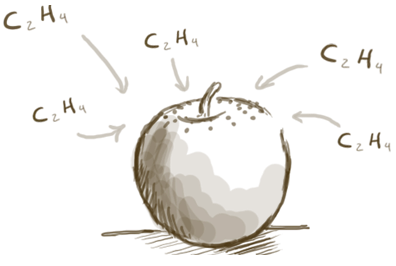Science of Bluapple®

Ethylene gas is given off naturally by fruits and vegetables as a signaling mechanism in order to coordinate uniform ripening. However, once concentrated in your refrigerator or other storage areas, the presence of ethylene gas continues to speed up ripening and hasten spoilage.
The Bluapple® is designed to provide effective ethylene gas absorption for three months in a typical home refrigerator produce bin or storage container. The active ingredient does not "wear out", but continues to absorb ethylene until it has reached its capacity. A OneYear Refill Kit rounds out the Bluapple® ethylene gas management product line, allowing consumers to reuse Bluapples® and not add them to landfills.
Carbon Bluapple® uses the same technology as Classic Bluapple®, with the added benefit of reducing odors and contaminants inside the refrigerator.
What is the specific chemistry of the reaction?
Ethylene gas (C2H4) is removed via an oxidation reaction wherein ethylene gas is changed to manganese oxide, water and carbon dioxide. For all you chemists out there, the balanced chemical reaction is as follows:
1. 3CH2CH2 + 2NaMnO4 + H2O = 2MnO2 + 3CH3CHO + 2NaOH
2. 3CH3CHO + 2NaMnO4 + H2O = 3CH3COOH + 2MnO2 + 2NaOH
3. 3CH3COOH + 8NaMnO4 = 6CO2 + 8MnO2 + 8NaOH + 2H2O
Combining chemical equations 1-3, we get:
4. 3CH2CH22 + 12NaMnO4 = 12MnO2 + 12NaOH + 6CO2
Even if the reaction does not go all the way through to the carbon dioxide-producing step, many of the intermediate products formed either become irreversibly bound to the media or act as reactants themselves. Such is the case of the sodium hydroxide (NaOH) formed in equation 1 and 2. The NaOH will react with the acetic acid formed in equation 2 to produce the sodium acetate salt (NaCOOCH3) through a simple acid-base neutralization reaction. This is shown below.
5. CH3COOH + NaOH = NaCOCH3 + H2O
Combining equations 1, 2, and 5 we get:
6. 3CH2CH2 + 4NaMnO4 = 3NaCOOCH3 + 4MnO2 + NaOH + H2O

